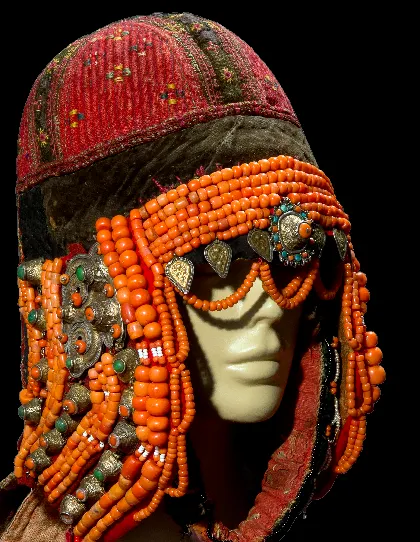
An opportunity to visit the famous Savitsky Museum of Arts became a real blessing for him. It was that visit that inspired the researcher to begin collecting things.
The Karakalpak wedding hat saukele is an item from the Albion Collection the researcher is particularly proud of. Initially, the collector managed to obtain a completely worn hat tumak, the base of a saukele, which needed be restored. How the team of the leading restorers of the Russian Museum of Ethnography in Saint Petersburg headed by V. L. Zheltova saved, cleaned and restored the item – an operation that took them many years to complete – deserves a special story.
Plait-covers attached to the hat tumak are decorated with embroidered zoomorphic motifs resembling horns – koltyksha muyiz (lit. an angular horn for the armpit), karsy muyiz (lit. an opposing horn); object motifs – shanyshky (a harpoon or trident with hooked elements), shilaush – a wood cutting tool; geometric motifs in the form of a cross. Long strips of embroidered textile attached to the hat from the back were known as khalka, khalaka (or alaka). The homemade textile (mate) was covered with floral motifs embroidered using the bosma technique. Jewellery was essential in the décor of a saukele. Apart from several rows of large coral beads, the front is decorated in the center with a badge adorned with fretwork, stones and beads. There is a special term for these types of badges – zhyga (a crown, circle) or khatep (a connector), while smaller badges found on a saukele are known as kyran (a hunting bird).
Symbolically, the ceremonial hat saukele combines elements of the three spheres: water, earth and heaven. The corals are the gifts of the sea. The numerous coral beads used in the decoration of a saukele were imported to Central Asia, perhaps, from the Mediterranean (Spain, France, Algeria, Tunisia or Turkey) or, more probably, from India and China, which made coral a very rare and exotic material. Metal adornments of gilded silver with turquoise are associated with the earth. The turquoise was produced locally – this mineral has been mined in Central Asia (in the territories of present-day Uzbekistan and Kazakhstan) for over 2,000 years – or could even be imported from Iran (Nishapur) or China (Sichuan Province and Manchuria), as was mentioned in Marco Polo’s travelling notes. So, tumak, the cruciform element of the hat, and its dome-like shape symbolise the celestial sphere (solar signs).
The Karakalpak saukele, of which just a few examples have remained to this day (including some in the Albion Collection), is a type that best represents the traditional Karakalpak art, demonstrating the well-thought-out design and shape of the hat, the talent and technique of the jewellers and the skill and outstanding abilities of the embroideresses.
You can learn more about the topic in the book-album "The Cultural legacy of Uzbekistan in private collections of the USA and Canada" (volume XXXI) in the series "Cultural Legacy of Uzbekistan in the World Collections".
The main sponsor of the project is the oilfield services company Eriell-Group.
